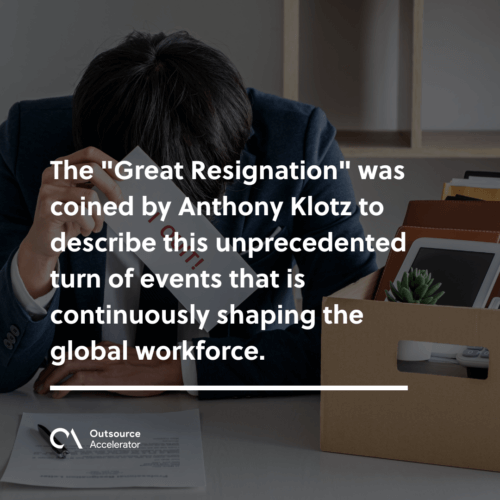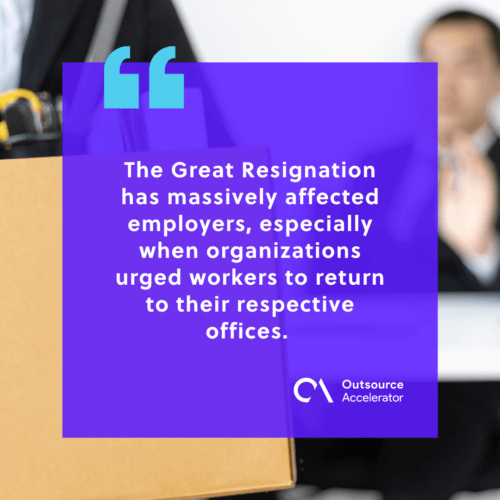What employers should have learned from The Great Resignation

Derek Gallimore is an Entrepreneur Leadership Network Contributor in Entrepreneur.com. This article was first published on Entrepreneur.
The Great Resignation forced leaders to think of effective ways and alternatives to retain staff. Here are the main takeaways employers should have grasped by now.
There is no denying that the world has shifted during the height of the pandemic. In the years 2020 to 2021, there has been a historic record of employee turnover, and this incident occurred globally. During this period of uncertainty, it has coaxed individual workers to re-evaluate their employment obligations and priorities.
Meanwhile, employers were also forced to course through the ripple effects of The Great Resignation. They were urged to think of effective ways and alternatives to retain staff. It is safe to say that employers have learned a lot from this pandemic-led phenomenon.
What drove The Great Resignation?
The “Great Resignation” was coined by Anthony Klotz to describe this unprecedented turn of events that is continuously shaping the global workforce. It transpired when employees from across the globe opted to quit their jobs for greener pastures.
While The Great Resignation may have emerged as a result of the pandemic, experts argue that this trend started even before the global health crisis. Records show that from 2009 to 2019, there was an average rate of 0.10% increase in people quitting their jobs every year. This inclination changed in 2020, as many employees decided to hold on to their jobs because of the uncertainties brought about by Covid-19.
But as apprehensions abated and businesses started embracing remote work, the job market was back to the so-called, long-term trend. According to the U.S. Bureau of Labor Statistics, over 47 million workers in the country quit their jobs in 2021. Flexibility is one big contributing factor to why many working professionals now choose to join the movement in post-pandemic times.

Why employees join The Great Resignation
To explain it further, many employees take part in The Great Resignation revolt because of the following:
Toxic work environment: A study conducted by Flexjobs has revealed that 67% of employees leave their companies due to toxicity in the workplace. There is no growth if the work culture is toxic — not just in the employees themselves, but in the entire organization.
The lack of recognition: Unappreciation and undervaluation will cause a downturn in employee morale. The lack of recognition leads to unmotivated staff, which in turn, will have a big impact on their productivity and performance. Eminently, it is another deciding factor for employees to look for better opportunities elsewhere.
Underpaid staff: Another survey led by Pew Research Center recorded that 63% of American workers quit their jobs because the pay was too low. The same survey also found that the employees who quit their jobs have already been employed in a different company with better salaries and opportunities.
How businesses were impacted by The Great Resignation
The Great Resignation has massively affected employers, especially when organizations urged workers to return to their respective offices. It led to companies increasingly having open positions, which also caused disruptions in their daily operations. Thus, the remaining employees needed to compensate for the lack of manpower. Immense workloads drove work-life balance, affecting their overall performance and productivity.
Businesses were forced to fill in vacant positions urgently. Not to mention, mass hiring requires a bigger budget, and in most cases, the quality of the hiring process is compromised.

What employers should have learned from The Great Resignation
One thing is certain, The Great Resignation has changed how traditional employer and employee relationships work.
In Gartner‘s 2022 research on IT workers, 70% of IT professionals appeal for employers to integrate a more “human-centric” work model. To help pacify the rising employee turnover rate, employers should come to terms with the following:
- Flexibility is the key: Work-life balance has become an essential aspect of every individual’s life. Working from home lets employees spend more time with their pets and loved ones while they perform their daily tasks. Flexibility enables employees to feel more satisfied with their work. It helps create a stress-free working environment, and it encourages staff to be more productive and improve their quality of work.
- Employers must shift their focus: Companies must adapt to today’s new normal, and this includes modifying their workforce methods according to the needs of today’s workers. It should incorporate a win-win situation between employers and their staff, as this will help attract the right candidates and retain them.
- Support employee development: Employers should also be able to support their employees’ career growth and development, as today’s workers seek long-term stability. Being able to provide skill-enhancing training and other career growth opportunities will not only benefit individual staff members, but also the entire organization.
- Create productive conversations: Employees are also more likely to be satisfied at work when they feel like the management values their well-being. Employers should open productive conversations wherein staff are free to share their queries, issues and ideas. This can also help foster good working relationships and help find answers to solve particular problems within the organization.
The Great Resignation is unavoidable, and it is still happening as employees continue to look for job opportunities with greater working conditions. From The Great Resignation to The Great Talent Reshuffle — the key here is to retain employees. Businesses should implement changes and revamp their rules to rectify the mass movement.







 Independent
Independent




